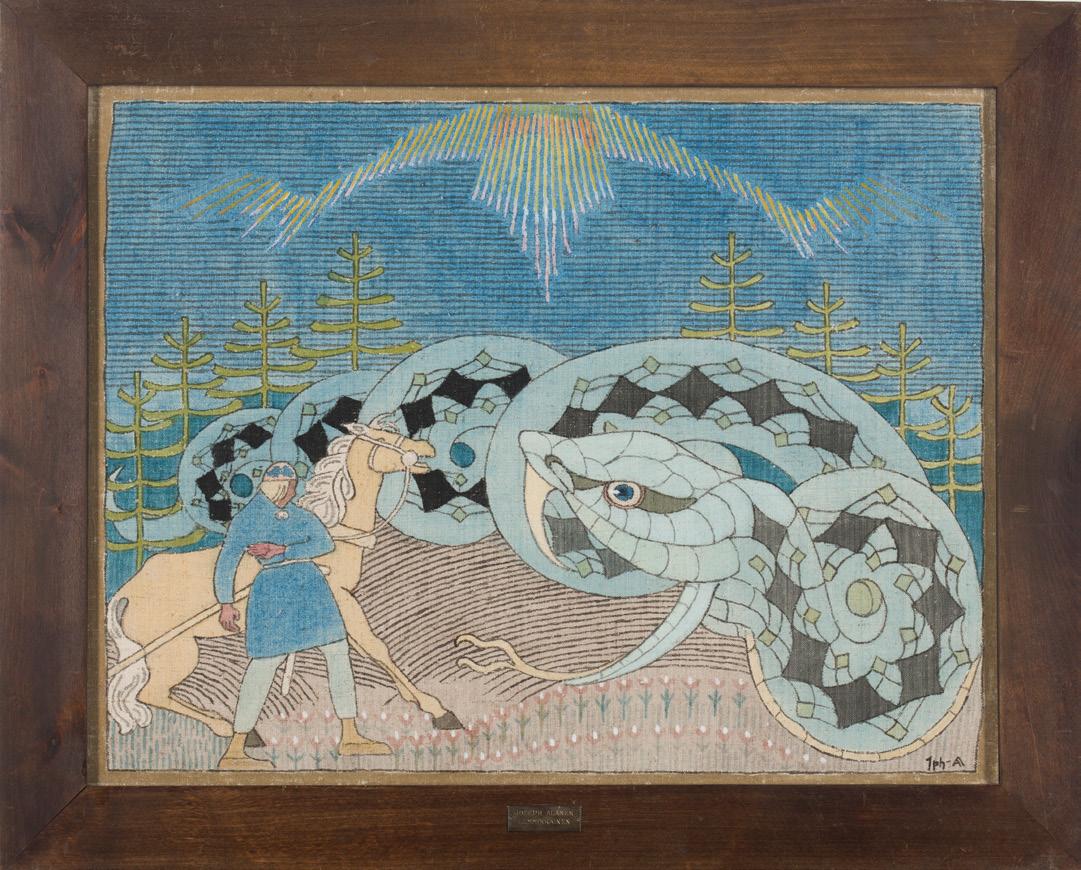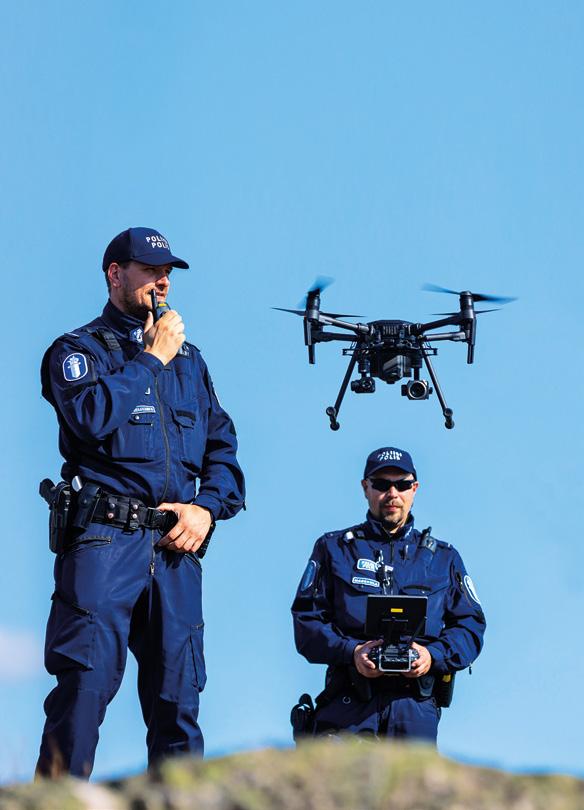
9 minute read
Kalevala illustrator Joseph Alanen
Lemminkäinen and the Great Serpent, 1919–1920, tempera on canvas.

Advertisement
Tampere Art Museum pays tribute to the forgotten Kalevala illustrator Joseph Alanen J oseph Alanen (1885–1920) was among the most accomplished artists to have drawn inspiration from the Finnish national epic, The Kalevala. The son of a Tampere-based foreman, Alanen is lesser known to wider audiences largely because his work has never been featured in a major exhibition prior to now. In 1920, Alanen, aged only 34, met an untimely death after contracting Spanish influenza, but his oeuvre is astonishingly rich in view of the brevity of his career. Tampere Art Museum now presents an extensive selection of his Kalevala-themed paintings, rounded out by his portrayals of peasant life, religious motifs, prints and drawings. Text by Tampere Art Museum. Source: Tapio Suominen’s article in Joseph Alanen – Jugend • Kalevala • Tampere Joseph Alanen. pho t o: P ri v a t e collec t ion


Fairy Maidens of the Waters, 1919–1920, tempera on canvas.
Student years Joseph Alanen’s artistic education did not follow the conventional path via Finnish art schools, as he resided in Sweden and Germany during most of his formative learning years. While training to become an electrician in Tampere, Alanen took an interest in telecommunications, and in 1906 secured an internship with the Ericsson telephone company. While based in Stockholm, he applied to get into art school, and was downright dazzled by the Swedish capital, which offered boundless visual inspiration.
His first trip to Berlin took place in 1906. Officially he was there to further his vocational studies as an electrician, but he took the opportunity to also sign up for art school, where he received lessons from Lovis Corinth. Alanen carefully studied the ethnographical collections of Berlin’s museums and new archaeological discoveries, which introduced him to the art of primitive ornamentation.
In his homeland, Alanen spent four years studying under Kaarlo Vuori, an accomplished portraitist remembered as Tampere’s first full-time professional artist.
Forging of the Sampo, 1910–1911, tempera, gold- and silver paint on canvas.
In autumn 1911 Alanen made his Helsinki debut. His Kalevala motifs were well-received and the reviews were generally encouraging, albeit their decorative content stirred perplexed responses. The mixed reactions appear to have stemmed from confusion over the genre his paintings represented. Being painted directly on unprimed linen, his canvases gave the impression that they were sketches for tapestries.
While the 1910s marked a turbulent era for Finnish art and society, for Alanen it was a busy period of diverse projects: he furthered his studies, taught, illustrated, accepted commissions, and held exhibitions. He continued painting Kalevala motifs as well as religious and historical paintings, landscapes and a few portraits. The linocut was the only printmaking technique he wholeheartedly adopted as his own, as it offered the best fit with his simple, stylized expression. Although he experimented with various styles in his freer compositions, his work always retained its inherently ornamental character. Over time, however, Alanen began to have misgivings about The Kalevala, presumably because he faced both artistic and financial pressure to broaden his repertoire.
First exhibitions Alanen made his debut at the Finnish Art Society’s group exhibition in Tampere in 1906. His early works were modest, sombre-toned romantic landscapes depicting stormy lakes and idyllic natural scenery. After a sojourn in Berlin and Stockholm, he returned to Tampere and set up a studio alongside his parents’ residence. In 1909 Alanen made his fourth trip to Berlin. Although painting was now his main occupation, Alanen was prevailed to supplement his income with other work: by doing illustrations for magazines, writing occasional art reviews, and teaching colour theory. Inspired by The Kalevala Alanen held his first solo exhibition in 1910 in sculptor Viivi Palander’s studio on Tampere’s town square. The show featured a handful of Kalevala-themed works alongside a selection of romantic-style paintings. Alanen had ambitions to illustrate the entire national epic poem by poem, and the lyrical world of folk mythology never ceased to fuel his creative imagination. Brief marriage In 1915 Alanen became engaged to his Oulu-based student Anna Väyrynen. On a visit to the Oulu region, Alanen painted the watercolour composition Tar Boat, which was unveiled in Helsinki in 1918. The couple married in 1917, but the marriage was to remain brief, stormy and childless. According to relatives, Alanen lost his will to live due to the unhappy union. Return to The Kalevala After the end of the 1918 Finnish Civil War, Alanen relocated from Tampere to Helsinki. Defying critics, Alanen resumed painting the same epic Kalevala motifs he had already visited earlier in his career. This was a peak period for Alanen; it was then that he painted many of his finest and most liberated Kalevala compositions. When Alanen died in spring 1920 – rapidly succumbing to Spanish influenza – he was well on the way to securing a commission to illustrate The Kalevala. The Kalevala The Kalevala is the national epic of Finland. It is based on Karelian and Finnish folk poetry compiled by Elias Lönnrot (1802–1884). The first version of The Kalevala (called The Old Kalevala) was published in 1835, followed by The New Kalevala (currently known as The Kalevala) in 1849. The trochaic tetrameter of the poems is known as “Kalevala metre”. At the time Alanen began illustrating The Kalevala, the epic was already nearly a century old. ALANEN HAD AMBITIONS TO ILLUSTRATE THE ENTIRE NATIONAL EPIC POEM BY POEM, AND THE LYRICAL WORLD OF FOLK MYTHOLOGY NEVER CEASED TO FUEL HIS CREATIVE IMAGINATION. 24

Aapo Huhta.
The Young Artist of the Year 2020 - Aapo Huhta
Aapo Huhta’s exhibition will be open in summer 2020. Huhta is an artist photographer working in Helsinki. He graduated as Master of Fine Arts from Aalto University in 2015 and focuses on experimental documentarism. The art of books of photography and related experiments with different methods and narratives are important aspects of his works. Huhta has published two books of photographs, Block (Kehrer Verlag, 2015) and Omatandangole (Kehrer Verlag, 2019) and has held solo exhibitions in Finland, Germany and Sweden. Aapo Huhta is the 36th Young Artist of the Year. "I photographed the works for my first two books in New York and in the desert of Namibia. The themes on which I work are not completely clear to me when I start. This vagueness is one of the things that I enjoy most in photography – it leads me beyond my own imagination. It is necessary to lose my way. I find the greatest satisfaction if I finally find my way, if I myself learn to understand what my photographs are ultimately about. That is when the piece is finished, having formed itself as it were.
I often find myself creating photographs in which familiar things become unfamiliar, the everyday becomes unreal, or things just look strange. In my photographs, man is often lost. Even though everything around us is chaotic and disintegrating, it is possible to discover and make photographs that show it all as perfect and pristine, completely different from what reality seems to be. Maybe the perfect moment captured by the camera was after all true for an instant — like unattainable bliss, which always disappears as fast as it has appeared." s

TAMPERE ART MUSEUM Puutarhakatu 34 33100 Tampere www.tampereentaidemuseo.fi Please check exhibition times and opening hours from museum’s website or social media.
Spies and their equipment that changed the world The world’s first spy museum in the city center introduces you to the fascinating ways and means of real life James Bonds. Eavesdropping, hidden cameras, secret weapons, code breaking, e-mail hacking...


poliisimuseo.fi
Remember to say the code “We met at the hotel” to get free Agent Test!

Museum is open Mon-Sun 12-18 Admission 9€ / 6€ Agent Test 5€ Translation books in 10 languages!
www.vakoilumuseo.fi Satakunnankatu 18, Finlayson
20
FREE ENTRANCE | Vaajakatu 2, TAMPERE
• HISTORIC AND VINTAGE CAR EXHIBITIONS • RALLY MUSEUM • TRAFFIC PARK FOR CHILDREN • COFFEE SHOP • MUSEUM SHOP ...and much more! LUNCH EVERY DAY 1 1–14 Deliciou s Take t h e ti m e to Enjoy



MOBILIA AUTOMOBILE AND ROAD MUSEUM Kustaa Kolmannen tie 75 • 36270 Kangasala www.mobilia.fi Bus 40B from Tampere to Mobilia

Kimmo Pyykkö 19.9.2020–3.1.2021 ongoing exhibition Kimmo Pyykkö: Long Distance Atelier 6.6.–30.8.2020

Discover the working class history of Tampere. Finlayson factory area 200 years in 2020!
Welcome to a fascinating journey through the shared history of Finland and Russia!

B I R T H P L A C E S O V I E T U N I O N of
THE FINNISH LABOUR MUSEUM WERSTAS Väinö Linnan aukio 8 Finlayson area, Tampere
Tue–Sun 11 am–6 pm www.tyovaenmuseo.fi

FREE ENTRY!
THE LENIN MUSEUM Hämeenpuisto 28, Tampere
www.lenin.fi
1.9.– 31.5. Tue–Sun 11 am–5 pm 1.6.–31.8. daily 11 am–6 pm Tickets 8/6 €, free for children under 18 years.


Helene Schjerfbeck, The Red-Haired Girl II, 1915.

ART | ARCHITECTURE | HISTORY | CUISINE NORDIC EXPERIENCES
Unique art exhibitions and fascinating architecture. Pure tastes from Finnish nature in the Landscape Restaurant Gösta. Experiential history in the utopia of an energetic paper industry legend. The lapping of waves and the soughing of pines in the Finnish Lakeland and Art Town. A memorable and easy-to-reach experience in a distinctive art locality.
JUMP ON THE SERLACHIUS SHUTTLE BUS!
DEPARTURE FROM TAMPERE Tampere bus station 10.50 am Tampere railway station 11.05 am
ARRIVAL IN MÄNTTÄ Serlachius Museum Gösta 12.25 pm Serlachius Museum Gustaf 12.35 pm
DEPARTURE FROM MÄNTTÄ Serlachius Museum Gösta 5.20 pm Serlachius Museum Gustaf 5.30 pm
ARRIVAL IN TAMPERE Tampere railway station 6.45 pm Tampere bus station 6.50 pm
FAR OUT ART WITH A HISTORIC HEART | SERLACHIUS MUSEUMS | MÄNTTÄ | +358 3 488 6800 | SERLACHIUS.FI AWARDS: DOMESTIC TOURISM BUSINESS OF THE YEAR | MUSEUM OF THE YEAR IN FINLAND | THE WOOD AWARD | SPANISH INTERNATIONAL ARCHITECTURE PRIZE EXPLORE THE WIDE RANGE OF OUR EXHIBITIONS SERLACHIUS.FI

